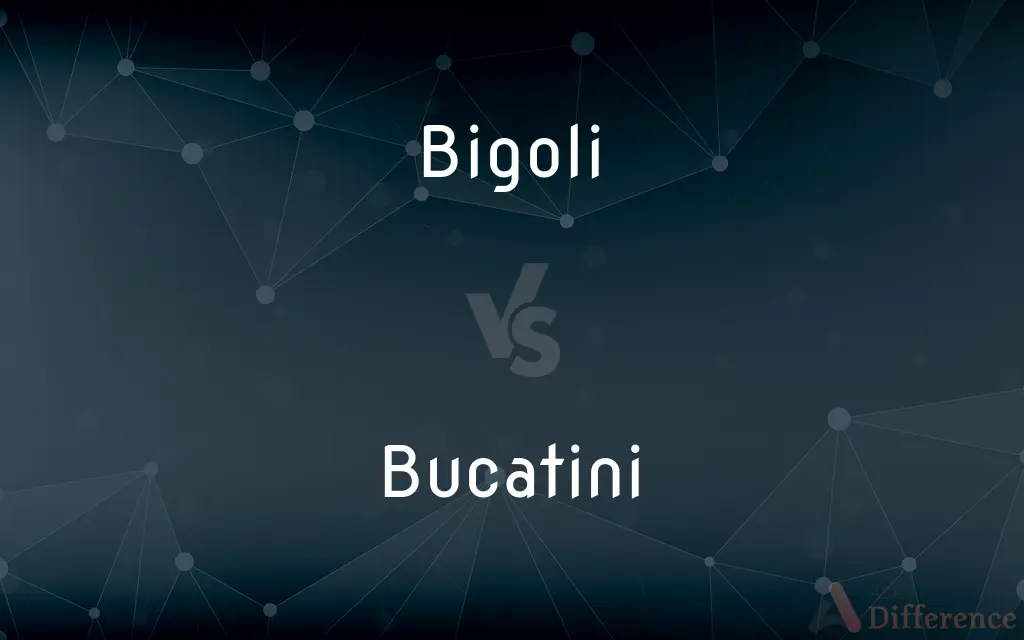Bigoli vs. Bucatini — What's the Difference?
By Fiza Rafique & Maham Liaqat — Updated on April 3, 2024
Bigoli is a thick, spaghetti-like pasta with a rough texture, ideal for holding sauces, while bucatini is a hollow, straw-like pasta, perfect for absorbing flavors.

Difference Between Bigoli and Bucatini
Table of Contents
ADVERTISEMENT
Key Differences
Bigoli, originating from the Veneto region of Italy, is a traditional pasta that resembles thick spaghetti but with a coarser surface, making it particularly adept at clinging to sauces. Whereas bucatini, though similar in shape to spaghetti, sets itself apart with a hollow center running through its length, originating from Lazio, especially Rome, which allows it to absorb and hold onto sauces in a unique way.
The production process of bigoli often involves the use of a bigolaro, a traditional press that gives the pasta its distinctive rough texture and slightly uneven thickness. On the other hand, bucatini is typically made with modern pasta extruders that create its uniform shape and characteristic hole, enabling a different dining experience where the sauce permeates both the outer and inner surfaces.
When it comes to pairing with sauces, bigoli's dense and hearty texture makes it an excellent match for rich and robust sauces, such as duck ragù or thick vegetable sauces common in its region of origin. Bucatini, meanwhile, is famously served with all’Amatriciana, a spicy tomato and pancetta sauce, showcasing its ability to blend harmoniously with both the sauce's texture and flavor.
The ingredients in bigoli may include whole wheat flour, which contributes to its denseness and nutritional value, offering a more rustic and hearty pasta option. Bucatini, however, is typically made from durum wheat semolina, which results in a pasta that is slightly lighter in texture but with a unique ability to marry with the sauce it is served with.
Both pastas reflect the culinary traditions of their regions; bigoli is a testament to the rustic and hearty fare of Veneto, often enjoyed during feasts and holidays. Bucatini represents the culinary innovation of Rome and Lazio, a beloved staple that has gained popularity well beyond its regional origins.
ADVERTISEMENT
Comparison Chart
Origin
Veneto, Italy
Lazio, Italy, especially Rome
Shape
Thick, long strands with a rough texture
Long strands with a hollow center
Texture
Dense and coarse
Smooth with a hole through the center
Sauce Pairing
Ideal for thick, hearty sauces
Perfect for sauces that can be absorbed
Production Method
Traditionally made with a bigolaro press
Made with pasta extruders
Ingredients
Often includes whole wheat flour
Typically made from durum wheat semolina
Cultural Significance
Reflects the rustic culinary tradition of Veneto
Emblematic of Roman and Lazio culinary innovation
Compare with Definitions
Bigoli
Ingredients may include whole wheat, contributing to its hearty appeal.
The whole wheat bigoli offered a more nutritious option at the table.
Bucatini
Characterized by its hollow center, making it ideal for absorbing sauces.
The bucatini perfectly captured the essence of the all’Amatriciana sauce.
Bigoli
Celebrates the rustic culinary traditions of the Veneto region.
During the feast, bigoli was served as a homage to Venetian cuisine.
Bucatini
Made using pasta extruders to achieve its distinctive shape.
The uniformity and hollow center of the bucatini are thanks to modern pasta extruders.
Bigoli
Often served with robust, hearty sauces in its native Veneto.
In Veneto, bigoli in salsa, a traditional anchovy sauce, is a popular dish.
Bucatini
Best paired with sauces that can fill its center, like all’Amatriciana.
Bucatini all’Amatriciana is a classic Roman dish we can’t get enough of.
Bigoli
A thick, coarse pasta that excellently adheres to sauces.
For dinner, we enjoyed bigoli tossed in a rich duck ragù.
Bucatini
Primarily made from durum wheat semolina for a smoother texture.
The semolina bucatini had a delightful texture that complemented the ragù.
Bigoli
Traditionally made with a bigolaro press for a unique texture.
The bigoli's rough texture, a result of the bigolaro press, held the sauce perfectly.
Bucatini
A staple in Rome and Lazio, embodying the region's culinary innovation.
In Rome, bucatini is a testament to the city’s love for pasta with a twist.
Bigoli
A type of spaghetti, with a rough texture, from the Veneto.
Bucatini
Bucatini (Italian: [bukaˈtiːni]), also known as perciatelli (Italian: [pertʃaˈtɛlli]), are a thick spaghetti-like pasta with a hole running through the center. They are common throughout Lazio, particularly Rome.
Bigoli
Bigoli [ˈbiːɡoli] (Venetian: bìgołi) is an extruded pasta in the form of a long and thick strand. Initially bigoli were made with buckwheat flour, but are now more commonly made with whole wheat flour, and sometimes include duck eggs.
Bucatini
Pasta in the shape of small tubes.
Bucatini
Pasta in long, hollow strands.
Bucatini
A thicker form of spaghetti with a hole running through it.
Common Curiosities
What is bigoli pasta?
Bigoli is a thick, spaghetti-like pasta with a coarse texture, originating from Veneto, Italy.
What sauces go well with bigoli?
Rich, hearty sauces like duck ragù or thick vegetable sauces pair well with bigoli.
Is bigoli vegan-friendly?
Bigoli can be vegan-friendly, depending on the ingredients used, which sometimes include eggs.
Why is bucatini popular in Roman cuisine?
Bucatini is popular for its versatility and ability to hold onto sauces, making it a favorite in Roman dishes like all’Amatriciana.
How is bucatini pasta unique?
Bucatini is unique for its hollow center, resembling spaghetti but with a straw-like hole running through its length.
Can bucatini and bigoli be used interchangeably in recipes?
While they can be substituted based on availability, their differing textures and sauce affinity may alter the dish's intended outcome.
How do the flavors of bigoli and bucatini compare?
The flavor of both pastas primarily depends on the sauces they are paired with, though whole wheat bigoli may have a more pronounced taste.
Is bucatini considered a traditional Italian pasta?
Yes, bucatini is a traditional Italian pasta, particularly in Lazio and Rome.
What is the main difference between bigoli and bucatini?
The main difference lies in their texture and shape: bigoli is dense and coarse, while bucatini is smooth with a hollow center.
Can bucatini be used with light sauces?
Yes, bucatini works well with both light and dense sauces, its hollow center allowing it to absorb flavors effectively.
Are there whole wheat versions of bucatini?
Whole wheat bucatini is available, offering a healthier alternative with a slightly nuttier flavor.
What is the traditional method of making bigoli?
Traditionally, bigoli is made using a bigolaro press, which gives it a unique texture.
How does the hollow center of bucatini enhance its pairing with sauces?
The hollow center allows sauce to flow inside and outside the pasta, ensuring flavor in every bite.
Can I make bigoli at home without a bigolaro press?
While a bigolaro press is traditional, alternative methods or similar pasta machines can achieve a comparable texture.
What makes bigoli suitable for thick sauces?
Its thick, rough texture allows bigoli to hold onto more sauce, making each bite flavorful.
Share Your Discovery

Previous Comparison
Behind vs. After
Next Comparison
Dreadnought vs. BattleshipAuthor Spotlight
Written by
Fiza RafiqueFiza Rafique is a skilled content writer at AskDifference.com, where she meticulously refines and enhances written pieces. Drawing from her vast editorial expertise, Fiza ensures clarity, accuracy, and precision in every article. Passionate about language, she continually seeks to elevate the quality of content for readers worldwide.
Co-written by
Maham Liaqat















































